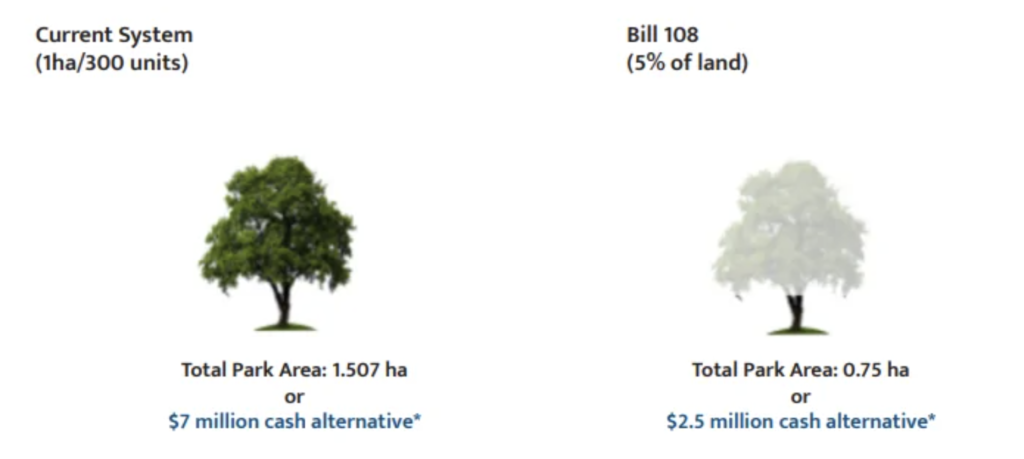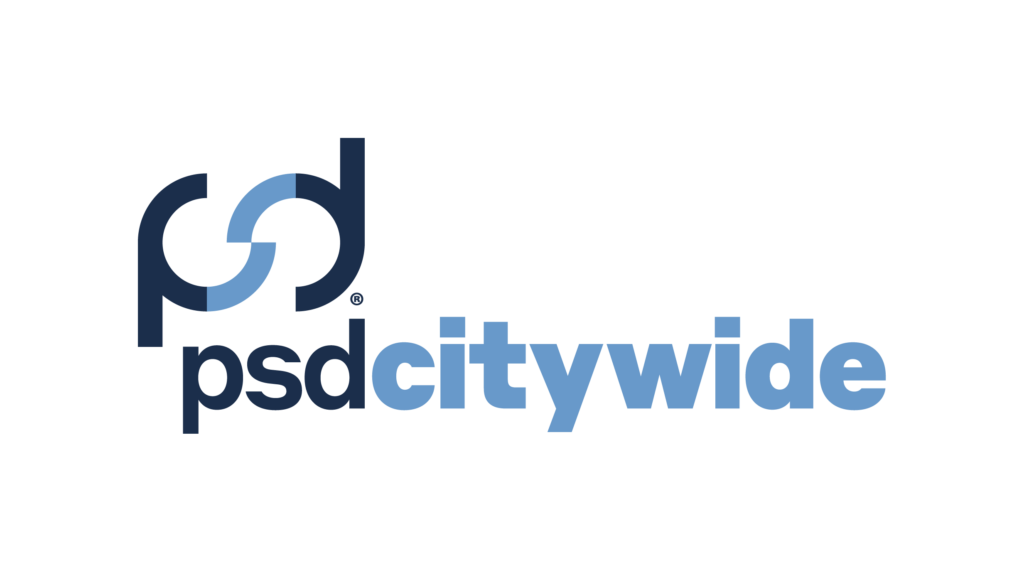The Province of Ontario’s Bill 108, the More Homes, More Choice Act, received Royal Assent on June 6, 2019. The Bill was introduced at the beginning of May 2019 and aims to increase affordable housing in Ontario. The contents of the Bill were met with significant backlash from municipal leaders in Ontario as it presents numerous amendments that could restrict municipal power and financial tools.
Bill 108 proposed amendments to 13 Ontario statutes as listed below.
- Schedule 1: Cannabis Control Act, 2017
- Schedule 2: Conservation Authorities Act
- Schedule 3: Development Charges Act, 1997
- Schedule 4: Education Act
- Schedule 5: Endangered Species Act, 2007
- Schedule 6: Environmental Assessment Act
- Schedule 7: Environmental Protection Act
- Schedule 8: Labour Relations Act, 1995
- Schedule 9: Local Planning Appeal Tribunal Act, 2017
- Schedule 10: Occupational Health and Safety Act
- Schedule 11: Ontario Heritage Act
- Schedule 12: Planning Act
- Schedule 13: Workplace Safety and Insurance Act, 1997
Statues of Municipal Interest
A number of the changes imposed by the More Homes, More Choice Act could impact local governments across Ontario. The following summary focuses on the statutes that could have direct implications for municipal leaders – this is not an exhaustive list of the amended statutes.
Bill 108 applies decisive changes to the Conservation Authorities Act. The mandatory mandate of Conservation Authorities (CA) is narrowed to include exclusively: natural hazard protection and management, conservation and management of conservation authority lands, and protection of drinking water sources. To carry-out a non-mandatory mandate which requires municipal funding, the CA must enter into an agreement to secure the funding. Furthermore, an investigator will be appointed to inquire into CA operations and finances.
Major amendments were made to the Development Charges Act, 1997 in favour of reducing development costs. The Province states that the reduction in development costs is intended to provide more housing options for Ontarians to make housing more attainable. The first amendment restricts development charges for discounter services – soft or social services – such as parkland development, transit, and libraries. Municipalities will be able to transition to the “community benefits charge” authority once the legislative provisions come into force; the proposed date is January 1, 2020. The legislative provisions for the community benefits charge are yet to be defined.
Another amendment introduces a list of types of development that will be subject to a deferral of development charges. The deferral of development charges will include for the development of the following: rental housing; non-profit housing; institutional buildings or structures such as retirement homes, universities, colleges, hospices, etc.; industrial buildings or structures used for manufacturing and storage, research, development, and retailing by or for manufacturers; and commercial buildings or structures such as office buildings or shopping centres.
In addition to the deferral, the amount of a development charge will be frozen at the time council receives the site plan application for a development, regardless of a deferral of charges. Municipalities will however be provided with the opportunity to charge interest on development charges payable during the deferral and during the development charge freeze. The interest cannot be charged at a rate higher than a prescribed maximum rate.
Finally, the building of additional dwellings in specified classes of residential buildings and ancillary structures as well as the creation of a second dwelling unit in new residential buildings will no longer trigger development charges.
Several short-term changes were made to the Environmental Assessment Act under Bill 108 while the Province develops a broader environmental assessment program. The changes to the Act are intended to reduce the regulatory burden on developers. Low risk routine activities – such as snow plowing, roadside park construction, and bike lane construction – will likely no longer require an environmental assessment process. Some Crown corporations and provincial ministries will be able to identify whether certain activities – related to transit, mines, parks, natural resource, and real estate – will not require further assessment or public consultation.
The Endangered Species Act, 2007 is amended to limit the restraints imposed to developers. A “landscape agreement” can be created between the developer and the Province to allow for activities that would otherwise be prohibited under the Act. The landscape agreement should include actions taken by the developer to limit the impacts on the species, such as a species conservation charge to the Species at Risk Conservation Fund. The payment of a “species conservation charge” to the Species at Risk Conservation Fund will now allow developers and municipalities to contravene the Act if the activities are related to a species listed as a conservation fund species. The funds will be distributed to a person or entity that is carrying out activities that will protect or recover species on the designated list created by the Ministry.
The Province will also have more flexibility to consider recommendations to the Species at Risk in Ontario List; they can take up to 12 months to add the species to the regulation and up to 3 years to require protection for the species once they are added to the List. The Province is given more power to amend the List, for instance, animals that exist safely in another nearby jurisdiction can be removed from a List, experts no longer have to be consulted on whether an activity will put the animal at risk, and developers can be given broad approval for multiple projects in one area.
The Local Planning Appeal Tribunal Act, 2019 has been amended to more closely resemble the Ontario Municipal Board – the Local Planning Appeal Tribunal (LPAT) prior to the name change triggered by the introduction of the Building Better Communities and Conserving Watershed Act, 2017. Bill 108 repeals the requirement that appeals can only be brought for one of the following reasons: inconsistencies with the Provincial Policy Statement, failing to conform with a provincial plan, or failing to conform with an Official Plan. Additionally, the LPAT will return to include a single hearing where the LPAT can make the final determination to approve, refuse, or modify the instrument under appeal. Furthermore, amendments to the LPAT Act restrict the ability of parties to introduce evidence and cross-examine and examine witnesses at hearings.
The More Homes, More Choice Act includes new amendments to the LPAT Act. Municipalities can pass a community benefits charge by-law which can apply to the following instruments: zoning by-law, plan of subdivision, minor variance, plan of condominium, and building permit. However, the Province will be able to exempt specific types of development from the charge. Furthermore, the timeline for municipal processing of development applications will be shortened, even shorter than before the introduction of the Building Better Communities and Conserving Watershed Act, 2017. Additional ways intended to lessen the backlog of appeals are introduced, such as increasing the number of staff members, restricting third party appeals, and promoting mediation to resolve appeals.
The Ontario Heritage Act is amended to include provincial direction to municipalities, property owners, and the public on how to interpret the Act thus limiting the flexibility of municipalities to make heritage designations. Furthermore, new timelines are introduced to require shorter response times from municipalities when making decisions under the Ontario Heritage Act. Finally, municipal decisions related to heritage designations can be appealed to the LPAT.
Several amendments were made to the Planning Act. Bill 108 requires municipalities to remove the majority of barriers to the establishment of additional residential units. Additionally, the timeline for council to make a decision on zoning bylaw and official plan issues before applicants can go to the tribunal for a decision is reduced.
Bill 108 amendments to The Local Planning Appeal Tribunal Act and the Development Charges Act are reflected in the Planning Act. A significant change involves the introduction of the community benefits charge which allows municipalities to impose a charge to pay for services, facilities, and matters required to develop an area. This will replace the parkland dedication in some cases, but the Province can exempt certain types of development from this charge. Annual reporting on the community benefits charge to the Province will henceforth be required.
The following types of developments will be exempt from charges for community benefits: long-term care homes, retirement homes, universities and colleges, matters of the Royal Canadian Legion, Hospices, and non-profit housing. Additionally, the following facilities, services, and matters will be excluded from community benefits: cultural or entertainment facilities, tourism facilities, hospitals, landfill sites and services, facilities for the thermal treatment of waste, and headquarters for the general administration of municipalities and local boards.
The formula for community benefits charges are yet to be determined but they are intended to maintain the revenue collected from development charges on soft or social services. The “community planning permit system” is a framework that replaces the individual zoning, site plan, and minor variance processes. Once a community planning permit system is in effect a community benefits charge by-law is no longer available for use.
The amendments introduced by Bill 108, and subsequently adopted through the More Homes, More Choice Act are not inconsequential. The Province and developers stand to benefit from the reduction in regulatory burden and the potential saving in costs. Municipalities, on the other hand, are being forced to relinquish power and financial tools. The results of these changes have the potential to alter Ontario’s political landscape.
Municipal Commentaries
Communities across the province have openly declared their dissatisfaction with Bill 108 through news outlets, town hall meetings, and municipal website postings. Since the More Homes, More Choice Act was adopted at the beginning of June, municipal leaders have come forward again as their concerns were not addressed prior to the Bill receiving Royal Assent. To address the remaining concerns, the Province has opened a platform for comments on certain schedules which will be closing at the end of August. As the discussion continues, the Cities of Brampton and Burlington have submitted commentaries to PSD Citywide.
The City of Brampton
Swimming Upstream: What’s at Stake for the Creation of Complete Neighbourhoods
By: Lowell Rubin-Vaughan, City of Brampton
Ask any prospective homebuyer what they look for in a neighbourhood of choice. Property cost is no doubt important, but so too are factors such as access to green spaces and public transit, proximity to recreation facilities, places of study and leisure, and respect for our cultural heritage. Balancing affordability with convenient amenities at arm’s reach is an attractive proposition for residents as they seek a great lifestyle. The creation of complete neighbourhoods is not just a buzzword but an important goal many municipalities are working towards. Enter Bill 108: More Homes, More Choice Act, 2019, recent provincial legislation that is making this approach more challenging. Based on the information currently available, this Bill is detrimental to the creation of complete neighbourhoods.
What’s the Issue?
The Province has said that Bill 108 will be revenue neutral for municipalities, but what’s been released so far doesn’t present a strong case for how revenue neutrality can be achieved.
Bill 108 will have serious impacts on municipalities and their residents. It combines three funding mechanisms municipalities use to fund parks, libraries, recreation centres and other community infrastructure (previously known as “Soft Development Charges”) into one community benefits charge (“CBC”). This CBC is subject to an arbitrary cap not based on the cost to deliver that infrastructure. Bill 108 may force municipalities to choose between delivering parks and providing other community facilities, or to reduce service levels by building smaller projects.
Municipal funding of hard services such as roads, sewers, and water mains are impacted by Bill 108’s deferral of the development charges calculation and collection, which means money from developers may not be available when needed, and in some cases might even be impossible to collect.
The Province views these initiatives as incentives to developers, but they come at a cost. Municipalities may be required to take on additional debt or raise taxes to ensure that service delivery keeps pace with development or increase taxes or take on debt to ensure that parks and recreation facilities do not become over-crowded and that hard infrastructure is in place when needed.
The simple truth is that under Bill 108, growth won’t pay for growth.
Another concern unrelated to funding but crucial to healthy city building and placemaking is the protection for cultural heritage resources provided by the Ontario Heritage Act. These protections are under attack. Under Bill 108, many decisions about heritage matters previously made by municipalities will now be made by the Local Planning Appeal Tribunal (formerly the Ontario Municipal Board). Municipal Councils are on the front lines to make better decisions in this regard than a provincially appointed body.
Simply put, the Bill imposes limits on municipalities’ decision-making and funding tools when it comes to planning and developing, and who bears the brunt? Unfortunately, residents. Consider a city such as Brampton, a growing powerhouse of people, talent and opportunities. Brampton is the second-fastest growing of Canada’s large cities with a population of over 600,000, set to grow to 890,000 by 2041. It has one of Canada’s youngest populations, with an average age of 36.5; and, with more than 52 percent of residents being born outside of Canada, Brampton is a beacon of diversity.
Strategically located close to Toronto Pearson Airport and along the Innovation Corridor between Toronto and Waterloo, Brampton is also a hot spot for new homebuyers. Every day, 47 people move to the Region of Peel – 38 of them to Brampton. This puts a great responsibility on City Council and staff to keep up the pace of providing services to a rapidly growing population. It is not a surprise that so many people are choosing to live here, given that the concept of complete communities is enshrined in the City’s 2040 Vision.
Reduction in Parklands
Brampton residents are accustomed to a high level of service from the City when it comes to parkland, with an average of about 1.8 hectares of parkland for every 1,000 residents. Bill 108; More Homes, More Choice Act significantly reduces, by nearly half, the ability for the City to acquire land from developers for park use.
The City’s Parks and Recreation Master Plan, adopted in 2016, recommends a target of 1.6 hectares of parkland for every 1,000 people. Current projections show a shortage of 54 hectares by 2031, a situation, which will be further compounded by restrictions introduced through Bill 108.
Cash in Lieu of Parklands
Sections 42 and 51 of the Planning Act allow municipalities to require a dedication of land – or payment in lieu of dedication – for park purposes. The requirement is two percent for commercial and industrial and five percent for all other uses, as a condition of development. There is also a unit-based calculation for high-density development, which Bill 108 will eliminate altogether.

Figure 1. Projected Changes to Total Park Area
The following table is an example of a pre-Bill 108 scenario for a subdivision in Brampton, where the City would have collected parkland dedication and nearly $19 million from the developer, as a condition of approving new residential units.
| Subdivision Brampton | |
|---|---|
| Revenue Tool | Current Planning Act and DC Act |
| Parkland Dedication (# acres) | 10.836 |
| Cash-in-lieu of Parkland ($) | $4,750,000 |
| Soft Development Charges ($) | $13,980,000 |
Under Bill 108, the City of Brampton would be faced with the following choice:
- Collecting 10.836 acres in parkland, plus $4,750,000 in cash-in-lieu of parkland; or
- Collecting a capped dollar amount through the Community Benefits Charge (CBC), in lieu of the $13,980,000 Soft DCs.
Going with either option could mean a significant loss for the City, as the cap (which has yet to be set by the Province) could prevent it from collecting nearly half of the $19 million.
Development Charges (DCS) & Community Benefit Charge (CBC)
Typically, Development Charges collected from developers (calculated using various parameters) are used toward both hard and soft infrastructure. Bill 108; More Homes, More Choice Act, however, does not allow municipalities to use Development Charges toward soft infrastructure such as recreation centres, libraries, parking lots, parks and playgrounds – amenities that matter to most residents.
To compensate for the loss of Development Charges, the Province has introduced Community Benefit Charges. The rules for setting DCs have not been released yet, but we do know that CBCs will be capped at a certain (still unknown) percentage of the current land value. This cap does not take into consideration other parameters such as the actual cost of delivering the services (e.g. – construction cost of a community centre). This system also means that areas of the City where land values are higher will benefit from more funding for soft infrastructure than areas where land values are lower. Basing CBCs purely on land value is a major loss for growing cities like Brampton, because land values here are lower than in places like Toronto, yet the cost of construction is similar across the Greater Toronto Area (GTA).
The cost to build the state-of-the-art Gore Meadows Community Centre and Library was around $100 million; Springdale Library was around $16.5 million. These prices generally reflect the cost of construction across the GTA’s larger cities. DCs based on the pre-Bill 108 funding scenario helped to build these award winning amenities, which are heavily used by Brampton residents.
One solution that Brampton will be proposing to the Province is that CBCs be subject to a variable cap, as the cost of providing soft services would be higher for high-density developments than for low-rise subdivisions.
Bottom line, the new rules take away municipalities’ capacity to secure money toward community infrastructure. While developers are benefitting by paying less to the City, there are no mechanisms in place to ensure that the benefits are passed on to the new homebuyer.
Lower Protection of Heritage Properties
Today, there are 259 properties in Brampton designated under Part IV and/or Part V of the Ontario Heritage Act, 22 properties in the process of being designated under Ontario Heritage Act and 386 other properties ‘listed’ on the Municipal Register of Cultural Heritage Resources which have not yet been designated. City Council makes decisions on heritage designations in line with relevant legislation.
Currently, if a property owner appeals a notice of intention to designate a property under Part IV of the Ontario Heritage Act, the appeal is heard by the Conservation Review Board (CRB) and the CRB decision would be considered by Council, which has final authority. Once Bill 108 comes into force, the final decision on any appeals of designations for individual properties will no longer rest with Council. Instead, those appeals will go to the Local Planning Appeal Tribunal (LPAT), and their decision will be final.
Not having City Council make the final decision could mean that a Brampton-made solution or consideration of locally important cultural heritage resources will not be given much attention.
In addition, proposed limitations on the designation of individual properties following prescribed events yet to be defined by regulation and the introduction of mandatory timelines for the designation process will likely significantly reduce the City’s ability to protect the cultural heritage resources within its boundaries.
Facing Reality
Housing supply and affordability need to be addressed in a more holistic manner, and not by offering incentives to developers and hoping that those benefits are passed on to the homebuyer. Here are some issues to consider:
- Housing supply is not the real issue: In Brampton, there are approximately 24,000 units of various residential types that have been approved, but not yet built. In these cases, the developer has not undertaken the work required to complete the final registration or construction. The issue is the willingness of partners to build the type of development that is required in Brampton – high-density multi-residential dwelling units. Twelve percent of all housing units in Brampton are multi-family households, compared to the national average of two percent.
- Loss of DC revenues: The 2019 DC Background Study showed that $390 million of anticipated revenue over ten years from soft DCs is now at risk under the new rules imposed through Bill 108. Essentially, the City could be underfunded for land for community facilities, or revenue to build community facilities.
- Impact to quality of life: When realtors are working with homebuyers, they highlight amenities as a key feature of the neighborhood. With fewer parks, recreation centers and libraries, what does this mean for overall quality of life?
- Financial pressures compounded: Brampton is already facing budgetary pressures. The province has canceled the doubling of the Provincial Gas Tax Fund and announced funding cuts to other services including Child Care, Paramedics, and Employment Services. Further loss of revenue of DCs will compound the financial challenges for municipalities that have no source of funding other than property taxes and user fees.
Finding a Way Forward
The one-month consultation window on Bill 108; More Homes, More Choice Act was inadequate, as municipal concerns were not reflected in the final bill. It is crucial for all municipalities to keep up their advocacy efforts related to the regulations under the More Homes, More Choice Act posted to the Environmental Registry of Ontario. Municipalities must continue to collaborate and advocate on behalf of their citizens. As for Brampton, we will continue to analyze the regulations under Bill 108 to respond to the Province with specific concerns and recommendations related to these significant legislative changes. We encourage all residents to participate in the consultations and to call and email their MPPs, Minister Clark, and Premier Ford.
As we await more clarity on the calculation of CBCs, we are heading into the 2020 Budget season knowing that tough decisions lay ahead when planning for new community facilities that are vital for our community.
LOWELL RUBIN-VAUGHAN is the Manager of Government Relations and Public Policy at the City of Brampton. He provides strategic guidance on intergovernmental affairs to the senior leadership team and City Council. He leads cross-departmental teams to address a diverse range of issues facing the municipal sector. Lowell has over 15 years of Government Relations experience, including 10 within the municipal sector, working on federal, provincial and municipal matters. Lowell has led initiatives in developing public policies and turning them into successful government relations strategies within the public and private sectors



